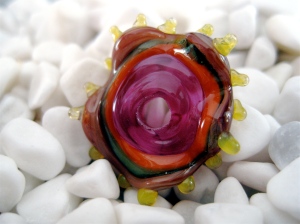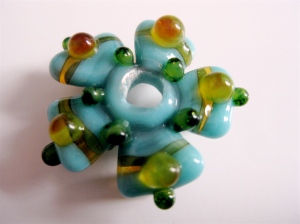Again, it’s been a while. Time away seems to have increased my confidence at the torch, perhaps not surprisingly. I realize, again, that there is no reason to be cautious with melted glass. If it doesn’t work, you haven’t lost much: some time and a few pennies’ worth of glass. The rewards of taking risks and experimenting are incalculable.
The Creation is Messy (CiM) glass I got at Frantz is delightful to work with. The colors are beautiful, it is stiff and malleable, and easy to sculpt. David asked me to do fireballs, and I had fun using CiM (gunmetal), Effrete (fire red), and Vetrofond (tangerine sparkle). How lucky they all have the same COE (104)!
For the fireballs: I used gunmetal (black) for the round base bead (for one of them I used a special millefiore and raked it through the black, which accounts for the bit of green you can see in the photo). I encased part of the base bead with red, then encased part of that with tangerine sparkle. I let all the glass melt and droop, then used a smasher to flatten the droop. I used glass scissors to cut it into sections, then used tweezers to pull the shapes. I added dots to one of the fireballs, and encased the head of the other one with clear glass.
I used the new CIM rose quartz, electric avenue blue, and celadon for the pastel dot beads. I couldn’t believe how the dots didn’t melt flat as I worked on the bead, and I was able to pull corners on green dots so easily. Unfortunately, I didn’t keep the base bead heated well enough as I worked (for a good 10 minutes), and it cracked (although it is still intact, it WILL break eventually). I love how the dots at the center of the green look like reduction glass. They are really just rose on blue on ivory dots. I did bubbles on the corners of the green, which you may not be able to see in the photographs.
I am very excited to enter a new phase of beadmaking. The fun will come from having better control of my technique, and I do feel steadier and more confident.















